Cruise missile submarines P-5
Work on the future P-5 rocket began in the middle of 1954, in a special design team led by V.N. Chelomey. In the summer of next year, the design team was transformed into OKB-52 with corresponding positive consequences for the efficiency of its work. The task of the project was to create a cruise missile with supersonic flight speed, capable of flying at a distance of up to 500 km and delivering a high-explosive or special warhead to the target. An important feature of the new project was to ensure the use of missiles on submarines. It was planned to start the development of such a submarine a little later, after determining the main design features of the rocket itself.
According to the results of preliminary studies, it was decided to build a new rocket using the classical aerodynamic scheme and equip it with a turbojet engine. An important feature of the new project was a folding wing with an automatic opening system. The use of a folding wing made it possible to drastically reduce the dimensions of the rocket in the transport position. The use of an automatic pickup system, in turn, could significantly accelerate the preparation of the rocket for flight. Previously, all domestic folding-wing rockets required manual opening and fixing of consoles. The new product was supposed to be the first rocket capable of uncovering the wing on its own after leaving the launcher.
Interestingly, in various sources there are several interesting versions of the emergence of the idea of automatic disclosure. According to them, V.N. Chelomey watched the birds or opened the window when the idea came to him to equip the rocket with a folding wing. However, these versions seem to be just legends. Work on the wing with automatic opening began in the year 1951 and continued until the middle of the decade. Thus, such an apparatus could hardly be the result of instantaneous illumination, but it was the fruit of long and complex work.
Design work on the new rocket, which received the designation P-5, continued until the 1956 year. By this time, all the main design tasks had been solved, including the development of wing automation. In the early spring of the 1957, tests began, but in the early stages only mock-ups of the new rocket, not equipped with a cruise engine, were used. This stage of the checks allowed the rocket to be prepared for full-scale tests.
The new rocket had a streamlined fuselage with a lively head fairing. For most of the length of the fuselage had a circular section, but in the tail under the bottom there was an air intake of the main engine, smoothly mated with other units. In the tail there was a conical engine nozzle. The rocket received a folding trapezoidal wing. A small section of the center section was fixed and rigidly mounted on the fuselage, and the rest was mounted hinged. In the transport position, prior to the release of the rocket from the container, the consoles should be positioned vertically and lie on the sides of the fuselage. After leaving the container, automatic equipment was turned on, lifting the console. The tail of the rocket consisted of several aerodynamic ridges and ventral keel with rudder.
The length of the P-5 was 11,85 m, the wingspan was 2,5 m, the maximum fuselage diameter was 1 m. The launch mass of the rocket with two solid-fuel accelerators was set at the level of 5,38 t. The rocket without starting engines weighed 4,3 t.
A new type cruise missile was designed to attack relatively large area targets, for which it was proposed to use an autopilot with a pre-entered flight task. During the flight, the autopilot AP-70А, which included the course automatic, the vertical axis, the barometric altimeter and the flight time counter, were to be responsible for controlling the rocket. In addition to the barometric altimeter, the possibility of using a radar system of a similar purpose was considered. The PB-5M radio altimeter was designed and tested, but was not used in the series.
The parameters of the rocket allowed to carry the warhead with a mass of about 870-900 kg. To hit a target, you could use a high-explosive warhead with a charge of several hundred kilograms or a special product like RDS-4. Such a warhead, borrowed from the P-11FM ballistic missile, had a power of 200 CT. In the future, it strengthened to 650 kt with a corresponding increase in power.
The composition of the power plant missiles P-5 include two drop-down starting engine and one sustainer. The exit from the launch canister and the initial acceleration with simultaneous output to the march height was proposed to be carried out using two powder accelerators with an 18,3 t each. The fuel charge kept the engines running for 2 s. After they were turned off and the rocket was discharged, it was supposed to fly with the help of a cruising solid fuel engine KRD-26 with a weight of 2250 kg.
An interesting feature of the P-5 rocket was the dependence of the main flight characteristics on atmospheric conditions. Thus, at the air temperature of -24 ° C, the rocket could reach speeds of up to 384 m / s (1380 km / h), however, the maximum flight range was only 431 km. Atmospheric air with a temperature of + 40 ° C reduced the speed to 338 m / s (1215 km / h), but brought the range to 650 km. The average flight speed, regardless of the environment, was set at 1250 km / h.
The P-5 cruise missile was to be transported by the carrier and launched from the CM-49 launch canister. The container was a cylinder of length 12 m with an inner diameter of 1,65 m. On its inner surface rails were provided to hold the rocket in the desired position, as well as the necessary connectors for connecting the rocket and the onboard systems of the submarine carrier. On both sides the container was closed with hemispherical lids with a seal and creamer valves. In the transport position, the interior of the container should be filled with nitrogen. The design of the product CM-49 was developed taking into account the requirements for the strength of submarines. The container had to withstand water pressure at any depth of the submarine, up to the limit.
Projects of various carrier submarines, both developed from scratch and through modernization, implied a rocking installation of the CM-49 container. Before launching a rocket, this device had to be hydraulically raised to an angle of 14-15 degrees, ensuring proper launch.
In addition to the container and its hydraulics, the submarine was supposed to receive the “Coast” control system. Its task was to collect information about the location of the target and the submarine, the calculation of the flight task and its introduction into the rocket autopilot. The management of the container and launch was also the task of the “Shore”.
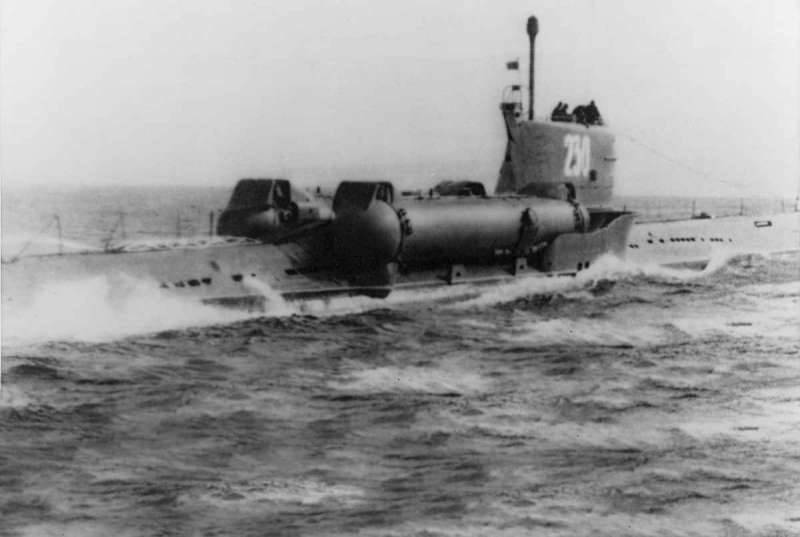
Submarine project 644. Two containers are clearly visible, mounted behind the wheelhouse fence. Wikimedia Commons Photos
In August, 1955 of the year, even before the completion of the missile design, work began on the conversion of one of the existing submarines to an experienced rocket armament carrier. As a test platform, it was proposed to use the C-146 diesel-electric submarine of the 613 project. The updated draft of the submarine received the designation 613-P. As part of this project, C-146 lost a number of feed units, such as a torpedo-loading device, artillery weapons, etc. Behind the felling fence, above the aft hull, mounted a rocking installation with a CM-49 container. In the stowed position, the container was to be placed horizontally and lay on the appropriate supports. Before shooting it was proposed to lift the container at an angle of 15 °. In this case, the rocket was supposed to pass directly above the wheelhouse.
The submarine of the 613-P project could launch P-5 missiles only in the surface position at speeds up to 8-10 knots. The excitement of the sea at launch was limited to 4-5 points. The refitted C-146 submarine participated in missile testing at all stages of the project. In 1962, it was re-equipped according to the original 613 project, dismantling the container and installing the standard equipment.
In the early spring of the 1957 of the year, according to a new design of the P-5, a model of the rocket was made for throwing tests. March 12 at the NII-2 test site in Faustovo, the first rocket launch without a cruise engine took place. According to the results of these tests, preparations began for subsequent inspections, which were planned to be carried out both on the stands and on the refitted C-146 submarine.
In August, the 1957 of the year on the floating 4A stand in Balaclava began full-fledged tests of the P-5 missiles in full configuration (with the exception of the warhead). To carry out such checks on an experimental test bench, we mounted a CM-49 container and a number of other equipment. Unfortunately, the first launch, which took place on August 28, ended in an accident. The second launch was also an emergency. The third and fourth launches, in turn, were successful. Bench tests ended in March 58-th.
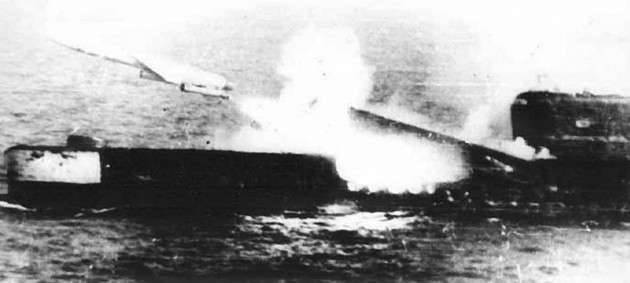
The submarine Ave 651 fires a P-5 rocket. Photo Kollektsiya.ru
22 November 1957, the converted C-146 submarine joined the tests. Missile launches from the submarine continued until January 1959. By this time, the crew of the submarine and industry experts completed 17 launches. Total, during the tests was used 21 rocket of a new type. Part of the launches ended in accidents, others led to the successful defeat of conventional targets.
A characteristic feature of the P-5 cruise missile was the use of the autopilot controlling the flight according to a predetermined program. There were no homing systems capable of searching for and targeting a target, or radio command control was not envisaged. During the tests, it was found that the applied equipment makes it possible to hit targets with a circular probable deviation of up to 3000 m from the calculated aiming point. Thus, the use of a special warhead with a power of at least 200 kt was fully justified and could ensure the defeat of enemy ships located in a predetermined area where the rocket is heading.
According to the test results, the P-5 rocket was recommended for adoption. The corresponding resolution of the Council of Ministers appeared 19 June 1959 of the year. The first carriers of advanced weapons were to be the submarines of several new projects. The head submarine of the new project was incorporated into the fleet at the beginning of 1960 of the year.
The submarines of the 5 project were to be the serial carriers of the P-644 missiles. In accordance with the resolution of the Council of Ministers of 25 in August 1955, it was required to develop a project for the modernization of submarines of the type "613" with the installation of the missile system of the new model. Specialists of TsKB-18 finalized the existing project, equipping it with two CM-49 containers behind the wheelhouse fencing. It was proposed to perform the run back, astern. Hydraulic systems for lifting containers and opening lids were used. Also, the 644 project implied the use of the Sever-A644U shooting control system.
According to its characteristics as a carrier of missile weapons, the submarine of the 644 project did not differ much from the C-146 submarine. The only noticeable difference was the possibility of shooting when moving at speeds up to 15 nodes. It should also be noted the need for a turnaround on the reverse course before launch, which could impede the combat use of missiles.
In the 1959-61, six submarines of the 644 basic design were converted by 613 design. All of them received new equipment and became carriers of the P-5 cruise missiles in two containers.
In the summer of 1956, the 651 project was launched. During this project, it was required to create the first submarine, originally intended for the use of P-5 missiles. In the autumn of 1960, a new submarine of the main project, K-156, was laid. Initially, the series was supposed to include 36 boats, but in the end only 16 was built. A characteristic feature of the new submarines was the presence of four containers CM-49, located on the sides of the hull. Two were located in front of the fencing of the cabin, the other two - behind. Because of this arrangement of containers in the sides of the hull large recesses appeared, designed to remove the gases of the starting engines. Later, similar systems of a similar type were used on other carriers of the P-5 missiles.
At the beginning of the sixties, the fleet received six diesel-electric submarines of the 665 project, which were another development option for the 613-type boats. Four containers for missiles were permanently located in the railing fence in an inclined position. The run was to be carried forward along the course. Under the 665 project, existing navy submarines were reworked.
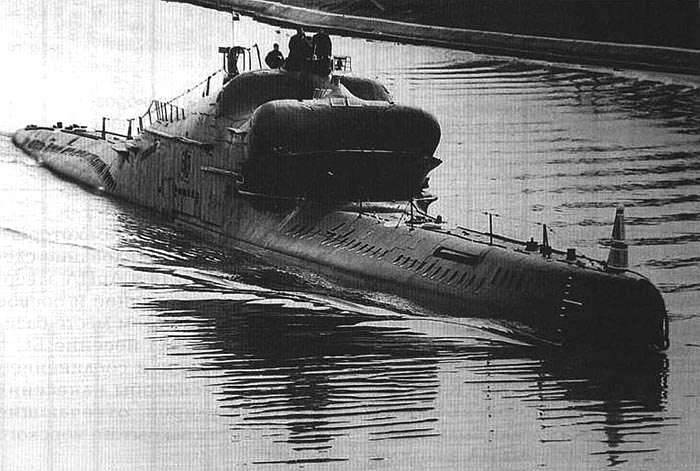
The submarine of the 665 project with a characteristic logging barrier, inside which are located four containers CM-49. Photo Moremhod.info
In the future, the P-5 missiles became weapons of nuclear submarines. The first such carrier of rockets became the submarines of the 659 project, which were built in the early sixties. Each of the five boats of this type carried six containers located in the hull, similar to the 651 project. Two were located in front of the fencing of the cabin, the others - behind it. It was later built 29 submarine project 675 with eight launchers on each. This time, six containers with missiles were placed behind the cabin.
After the adoption of the P-5 rocket, several attempts were made to upgrade this weapon through the use of new components and assemblies. In 1959, a rocket was built and used, designated P-5CH. It differed from the basic version by using a radio altimeter instead of the basic barometric one. This project did not go beyond testing.
In order to improve the accuracy of guidance, the P-5-RG missile design with an active radar homing head was proposed. For various reasons, this project remained at the stage of preliminary studies. The homing missile was not built or tested.
In September, 1959 began testing the upgraded P-5D rocket. Its main difference from the base product was the autopilot AP-70D ("Doppler"). The Doppler gauge of the path and demolition in flight was introduced into this system, with the help of which it was possible to significantly reduce the influence of atmospheric phenomena and thereby improve the accuracy of hitting the specified point by two or three times. In addition, the radio altimeter was brought to operation. The PB-5M device allowed to reduce the height of the main part of the trajectory from 450 to 200 m, to a certain extent increasing the combat effectiveness.
Tests of the P-5D rocket were initially carried out on a ground stand. Subsequently, the C-162 submarine of the 644 project, which was remade according to the 644-D project, was attracted to the checks. The test launches of the new rocket continued until the middle of 1961. 2 March 1962 year it was adopted. Due to the maximum possible unification with the existing product, the P-5D rocket could be used by submarines already carrying the base P-5.
The operation of the P-5 and P-5D rockets continued until the 1966 year. After that, the rocket was removed from service, replacing it with newer complexes. In this regard, the existing media have been upgraded. Part of the 644 project submarines was re-equipped on the original 613 project, and the submarines of the new projects (651, 659 and 675) received new types of missile systems, while retaining the existing launchers.
The P-5 project became the basis for several other developments. The first product at its base was the P-6 rocket, which was distinguished by control and guidance systems. Simultaneously with the P-6, on the basis of the same developments, the P-35 rocket was created, designed to arm surface ships. Interestingly, the P-35 ship-launched missile was put into service in the 1966 year - almost simultaneously with the removal of the base P-5. In the future, based on modifications of the P-5, new missile systems were created, which were used to perform various combat missions.
According to some information, after the P-5 missile was deactivated and modified, it was upgraded and used as targets for training crews of the fleet's anti-aircraft complexes.
Despite the relatively short life span (1959-66 years), the P-5 cruise missile project was an important step in stories domestic rocket weapons. As part of this project, the task of installing cruise missiles on a submarine, as well as equipping the missile with automatic wing opening, was solved for the first time. In the future, all these developments were used in the mass of new weapons projects for ships and submarines. In addition, one of the results of the P-5 project was the appearance of the P-35 rocket, which was deservedly considered one of the best weapons of its class.
Based on:
http://bastion-karpenko.narod.ru/
http://navy.su/
http://kap-yar.ru/
http://kollektsiya.ru/
http://militaryrussia.ru/blog/topic-91.html
Shirokorad A.B. Weapons of the domestic fleet. 1945-2000. - Minsk: “Harvest”, 2001
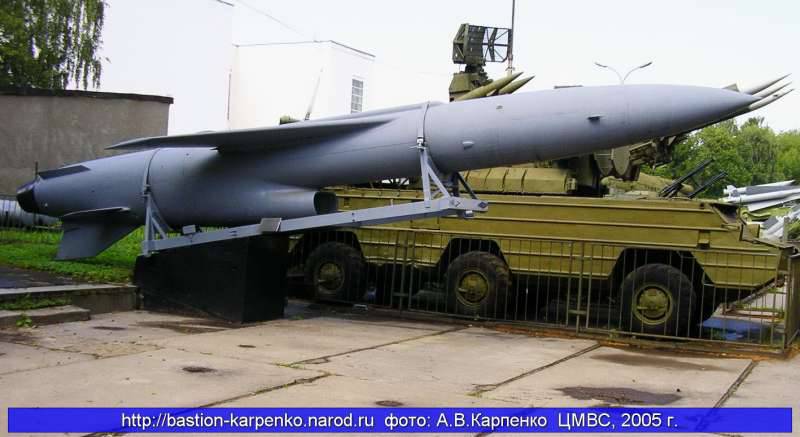
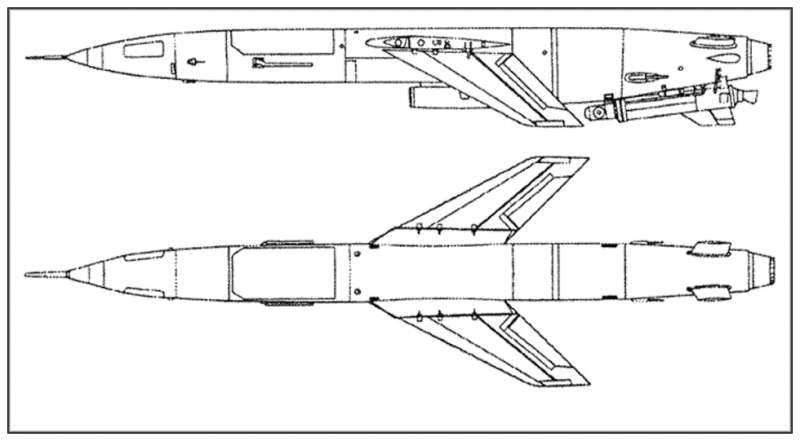
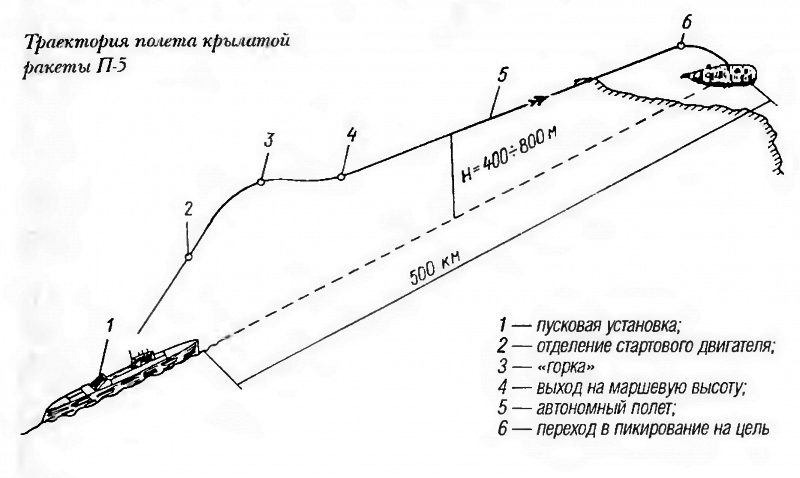

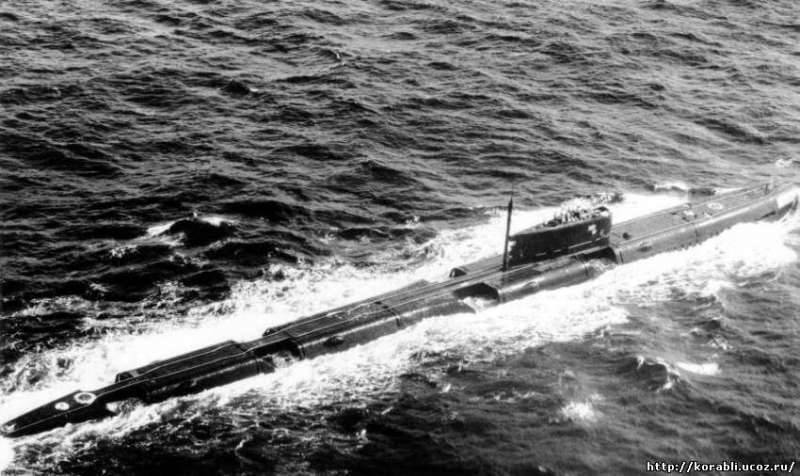
Information